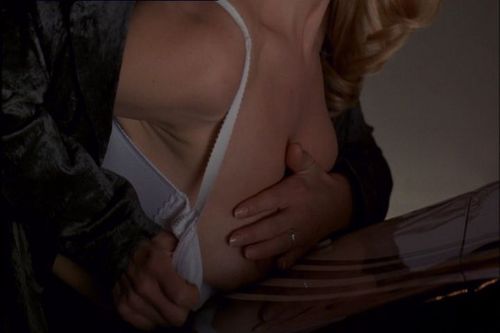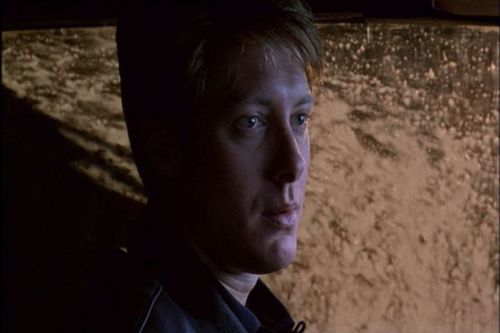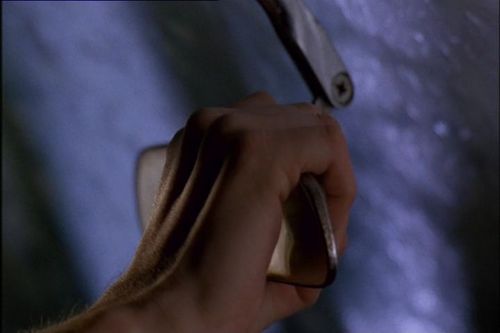August 27, 2006
Let me be your fantasy
k-punk's contribution to the inter-weblog pornography symposium, attended (so far) by Infinite Thought, Bacteriagrl, Measures Taken, Different Maps and Poetix
What Ballard, Lacan and Burroughs have in common is the perception that human sexuality is essentially pornographic.
For all three, human sexuality is irreducible to biological excitation; strip away the hallucinatory and the fantasmatic, and sexuality disappears with it. As Renata Salecl argues in (Per)Versions of Love and Hate, it is easier for an animal to enter the Symbolic Order than it is for a human to unlearn the Symbolic and attain animality, an observation confirmed by the news that, when an orang-utan was presented with pornography, it ceased to show any sexual interest in its fellow apes and spent all day masturbating. The orang-utan had been inducted into human sexuality by the 'inhuman partner', the fantasmatic supplement, upon which all human sexuality depends.
The question is not, then, whether pornography, but which pornography?
For Burroughs, pornosexuality would always be a miserable repetition, a Boschian negative carnival in which the rusting fairground wheel of desire forever turns in desolate circles. But in Ballard, and in Cronenberg's version of Ballard's Crash, it is possible to uncover a version of pornography that is positive, even utopian.
Cronenberg's work can be seen as a repsonse to the challenge Baudrillard posed in Seduction. Hardcore pornography haunts late capitalism, functioning as the cipher of a supposedly demystified, disillusioned 'reality'. 'A pornographic culture par excellence: one that pursues the workings of the real at all times and all places.' Here, hardcore is the reality of sex, and sex is the reality of everything else. Hardcore trades on a kind of earnest literalism, a belief that there is some empirically specifiable 'it' which = sex in/as the real. As Baudrillard wryly noted, this empiricist bio-logic is fixated on a kind of technical fidelity - the pornographic film must be faithful to the (supposed) unadorned, brute mechanism of sex. Yet, sign and ritual are inescapable: in hardcore, especially in bukkake, the function of semen is, after all, essentially semiotic. No sex without signs. The higher the resolution of the image, the closer you get to the organs, the more that the 'it' disappears from view. There is no better image of this 'orgy of realism' than the 'Japanese vaginal cyclorama' Baudrillard described in the 'Stereo-porno' section of Seduction. 'Prostitutes, their thighs open, sitting on the edge of a platform, Japanese workers in their shirt-sleeves ... permitted to shove their noses up to their eyeballs within the woman's vagina in order to see, to see better - but what?' 'Why stop with genitalia?' Baudrillard asks. 'Who knows what profound pleasure is to be found in the visual dismemberment of mucous membranes and smooth muscles?'
Cronenberg's early work - from Shivers and Rabid through to Videodrome - is an answer to that very question. Cronenberg famously posed his own question, 'why aren't their beauty contests for the inside of the body?', and Shivers and Rabid posit an equivalence between body horror and eroticism. The ostensible catastrophe with which both films conclude - the total degeneration of social structure into a seething, anorganic orgy - functions ambivalently. The disintegration of organismic integrity, the reversion to the condition of the pre-multicellular, is a kind of parodic-utopian riposte to Freud's Civilzation and its Discontents. If civilization and unbound libido are incommensurate, it is implied, so much the worse for civilization. The appartment block taken over by mindless sex zombies at the end of Shivers is the Sixties dream of liberated sex come true...
Crash is a sober retreat from all this, a model for a new mechoMascohistic mode of pornography in which it is no longer the so-called inside of the body that matters, but the body as surface - a surface to be adorned with clothes, marked by scars, punctured by technical machinery. Possessed by a mad passion to exchange biotic code, the sex plague victims in Shivers devolve beyond animality into a kind of bacterial replicator frenzy. By firm contrast, Crash is as passionless as a Delvaux dream. Sex here is entirely colonized by culture and language. All the sex scenes are meticulously constructed tableaux, irreducibly fantasmatic, not because they are 'unreal', but because their staging and their consistency depend on fantasy. The film's opening scene, with Catherine Ballard in the aircraft hangar, is quite clearly an acting out of a fantasmatic scenario; it also functions, later, via its recounting, as a fantasmatic supplement to the first sexual encounter we see between Catherine and James. There is no 'it' of sex, no brute, naked, definable moment when 'it' happens, only a plateau that is (paradoxically) both dilated and deferred, in which words and memories reverberate more powerfully than any penetration.
Crash is so indebted to Helmut Newton that it often looks like little more than a series of animated Newton images. Or, better: in Crash, the bodies attain the near-inanimate stillness of Newton's living mannequins. The echoes of Newton are entirely fittingly, since Ballard regarded Newton as 'our greatest visual artist', a Surrealist image-maker whose vision shamed the mediocrity of those officially working in the fine arts. 'In Newton's work,' Ballard writes, 'we see a new race of urban beings, living on a new human frontier, where all passion is spent and all ambition long satisfied, where the deepest emotions seem to be relocating themselves, moving into a terrain more mysterious than Marienbad.'
When Cronenberg talks about the future sexuality of the 'new race of urban beings' in Crash, he tends to refer to it negative terms. 'The conceit that underlies some of what is maybe difficult or baffling about Crash, the sci-finess of it, comes from Ballard anticipating a future pathological psychology. It's developing now, but he anticipates it and brings it back to the past - now - and he applies it as though it exists completely formed.' The Ballards' marriage is to be understood as inherently dysfunctional:
- Some potential distributors said, 'You should make them more normal at the beginning so that we can see where they go wrong.' In other words, it should be like a Fatal Attraction thing. Blissful couple, maybe a dog and a rabbit, maybe a kid. And then a car accident introduces them to these horrible people and they go wrong. I said, 'That isn't right, because there's something horribly wrong with them right now. That's why they're vulnerable to going even further.'
Yet the Ballards 'pathology' in Crash seems oddly healthy, their marriage a model of well-adjusted perversity. Theirs is a utopian sexuality, where sexual contact is voided of all sentimentality, stripped of any reference to reproduction, and unfreighted by any guilt. The lack of face-to-face sex in the Ballards' marriage - which, again Cronenberg himself tends to talk of negatively, as if it were a deviation from some wholesome, facialized sex in which the partners achieve a harmonious oneness - points to an awareness that there is no sexual relationship. Yet, very far from being a difficulty for the Ballards' marriage, the lack of a direct rapport, the recognition that any sexual encounter has to go via fantasy, is the basis of all their erotic adventures. Compare the Ballards' marriage to that of the Harfords in Eyes Wide Shut. The Ballards' using of their sexual encounters with others as a stimulus for their own - impassive, poised, oneiric - sex forms a clear contrast with the deadlock of the Harfords' marriage, which is exposed in Bill's failure to cope, or keep up, with Alice's fantasy. While Bill is scandalized by Alice's articulation of her fantasies, sex in the Ballards' marriage is governed by the 'feminine' drive to talk; it is almost as if all of the physical encounters happen only so that they can be converted into stories to be recounted later.
The most charged scene in Crash takes place in the carwash, where James looks on through the rearview mirror at Catherine and Vaughan, who - in the words of Cronenberg's script - are 'like two semi-metallic human beings of the future making love in a chromium bower'. Deborah Unger, the film's real star, is particularly impressive here. A kind of feline automaton, she 'acts with her hair, minor adjustments, tosses of the head that advertise the transit of small emotions.' (Iain Sinclair)
Who is using whom here? The answer is that all three of the characters are using each other. Catherine's encounter with Vaughan stimulates James, just as Catherine is stimulated by the thought that James is watching her with Vaughan. Vaughan is using the couple as subjects of his own libidinal experiments, while the Ballards are using Vaughan as the third figure in their marriage. A mis-en-abyme of desire...
Far from being some nightmare of mutual domination, this is Cronenberg/ Ballard's sexual utopia, a perverse counterpart to Kant's kingdom of ends. The kingdom of ends was Kant's ideal ethical community, in which everyone is treated as an end in themselves. Kant reasoned that, from the point of view of his ethics, sex was inherently problematic, because to engage in sexual congress entails treating the other as an object to be used. The only way in which sex could be commensurated with the categorical imperative - which in one of its versions maintains that one should never treat others as a means to an end - was if it took place in the context of a marriage, in which each partner has contracted out the use of their organs in exchange for the use of their partner's.
Desire is construed here in terms of simple appropriation (this equivalence is yet another way in which Kant is in tune with Sade). But what Kant - and those who follow him in condemning pornography because it 'objectifies' - fails to recognize is that our deepest desire is not to possess an other but to be objectified by them, to be used by them in/ as their fantasy. This is one sense of the famous Lacanian formula that 'desire is the desire of the other'. The perfect erotic situation would involve neither a dominance of, nor a fusion with, the other; it would consist rather in being objectified by someone you also want to objectify.
Crash, of course, follows Masoch and Newton in delocalizing sex from genitality. Libido is invested in the mis-en-scene more than in the meat, which draws its attraction almost entirely from its adjacency to the decorous nonorganic - to clothes as much as cars. Clothes differentiate Glam's cold and cruel cultivation of appearances from hardcore's passion for the real. Without suits, dresses and shoes, without fur, leather and nylon, pornography might as well be arranging meat in a butcher's window. Newton told Ballard that he 'loved Cronenberg's Crash, but one thing bothered him. 'The dresses,' he whispered. 'They were so awful.'' This strikes me as waspishly unfair to Denice Cronenberg's elegant wardrobe selections. (One major problem with Jonathan Weiss' version of The Atrocity Exhibition, however, is precisely the dreadfulness of the clothes.) Crash takes its cues from high fashion magazines, whose images are more sumptuously arty than fine art, more suffused with deviant eroticism than hardcore porn. Would be impossible for there to be a pornography, sponsored by Dior or Chanel, scripted by a latter-day Masoch or Ballard, whose fantasies were as artfully staged as the most glamorous fashion photo shoot?
Thanks to Infinite Thought for DVD scans
Posted by mark at August 27, 2006 03:13 AM | TrackBack



